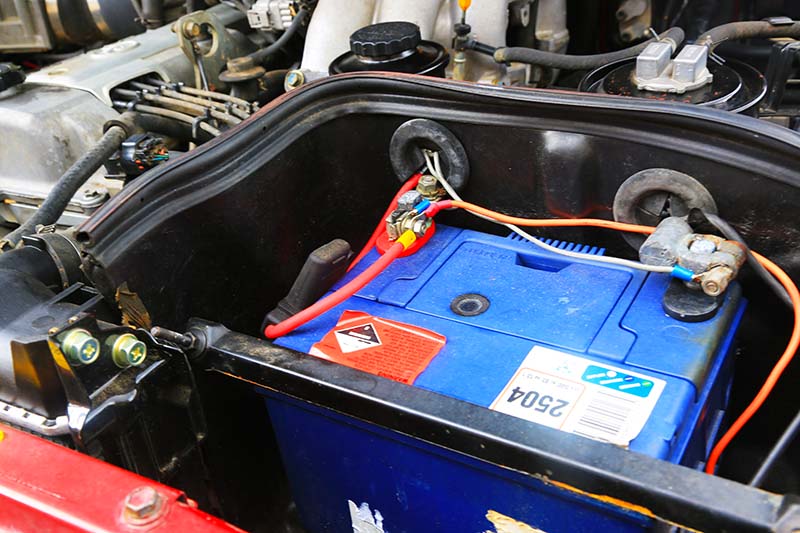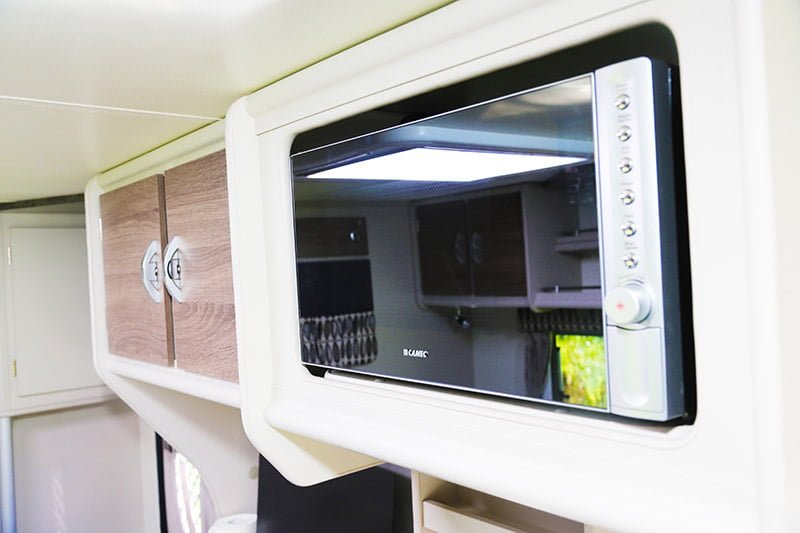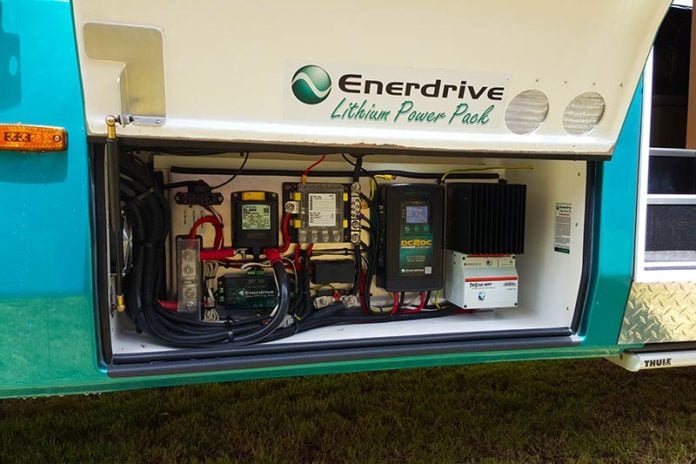Battery and associated matters are an area where two words, ‘energy’ and ‘power’, constantly confuse. Many see them as the same thing. They are not and that truly matters.
Energy relates to the ability to perform work. Power relates to how fast that energy is used.
[If you like this article, Like GoRV on Facebook!]
Weightlifter Olga can heave a 200 kg barbell overhead in a second or two with ease. She needs a lot of power to do so, and can only do that a few times a day. Marathon runner Fred moonlights by re-stacking supermarket shelves. He typically stacks two hundred 1 kg cans on a shelf two metres high every 15 minutes, and can do that for many hours.
When lifting 200 each kg through two metres, Olga and Fred do exactly the same amount of work. Each expends the same amount of energy. However, the power required to do so is very different. Olga’s is huge. Fred’s is far less – but as he may lift those cans for many hours, his available energy store and usage is much greater.
 A big 4WD starter motor is a battery-powered version of Olga. It needs some 400-500 amps – but only for a second or two. That is a lot of power but surprisingly little energy. At 12 volts, supplying 500 amps for (say) three seconds is less than about 0.5 amp hour (about that needed to run a six watt LED for one hour).
A big 4WD starter motor is a battery-powered version of Olga. It needs some 400-500 amps – but only for a second or two. That is a lot of power but surprisingly little energy. At 12 volts, supplying 500 amps for (say) three seconds is less than about 0.5 amp hour (about that needed to run a six watt LED for one hour).
Contrary to common belief, this typically depletes the starter battery by less than 2%. The alternator replaces that within a minute or two.
A pleasingly associated reminiscence is of a strong English girlfriend who could hand start my big four-cylinder 4.5 litre Bentley with ease. She would replace the expended energy by a single gin and tonic (although she mostly had two).
Running an RV’s lights and TV needs a very different type of battery. It is more marathon-running Fred-like than ‘don’t mess with me’ Olga. Deep-cycle batteries traditionally fill that role. The traditional lead acid versions still used are archaic, heavy and clumsy – but work.
OLD TECHNOLOGY
While batteries were invented around 1800, the first rechargeable version surfaced in 1859. It had two lead sheets separated by rubber and, even by today’s starter battery standards, could produce surprisingly high power. However, that, and those later, had limited energy storage.
That technology remained almost unchanged for 150 years! Power was rarely an issue but, at best, energy storage (per volume and weight) increased by a mere 50%. Even now, while lithium-ion (LiFePO4) batteries can release hugely more power, they only store and release about three times the energy for the same size and weight as the lead acid versions of over a century ago. And, as explained below, are unlikely to exceed that.
The later AGM batteries were developed to fulfil a very different need. It was to start US Army snowploughs in the Arctic after many months without recharge. They are mostly Fred-like but very rugged and with a tad more power.
Gel cells are a bit AGM-like but now less often used. They have a small but loyal following but it is unclear as to why.
NEW-ISH TECHNOLOGY
Lithium-ion battery development in earnest started in the 1970s and launched on a substantial scale in 2010. Early ones virtually doubled as random firelighters (and some still set fire to mobile phones), but after the odd Boeing or two, the later LiFePO4 variant proved less thermally volatile, but must still be used with caution. Most such batteries are Olga-like but (depending on their capacity) almost all can double as Freds.
It is lithium-ion’s ability to provide huge short-term power that enables tiny 18 amp hour versions to start a diesel Land Cruiser in a Hobart winter a likely ten times. However, that limited 18 amp hour energy can only run an RV’s (say) 40 watt TV for around five hours. Nevertheless, it is also handy for recharging your mobile phone many times.
RVs NEED BOTH ENERGY AND POWER
So far, we’ve looked mainly at extremes. All motorhomes and 4WDs have short term high power loads: both have power hungry starter motors. A 4WD may also have a both power and energy hungry winch. That winch is typically run from the starter battery (plus alternator back up) – but not for long.
Here, where feasible, a snatch strap is a far better alternative. It stores the kinetic energy of a couple of tonne of snatch vehicle in a kilo or three of elastic strap. In addition, it releases that energy with remarkably low loss.
For winch-like needs, pick a starter battery that has the ‘CCA’ (Cold Cranking Amps) the vehicle maker recommends. There is no benefit in having more. However, there is a second and vital rating. It is called Reserve Capacity. Here, pick the highest that you can fit. To some extent, that CCA reflects its power, the latter its available energy capacity. (It is a good way to choose starter batteries even if not needed for a winch.)
AUXILIARY BATTERIES
Caravans are becoming increasingly mobile-home-like. For both, the highest power load by far will be the microwave oven. It uses a lot of energy as well.
 Microwave oven ratings can deceive. While rated in watts, that wattage is not as most think. It’s not the power needed but its equivalent as heat – see it as sort of ‘cooking’ watts. The power draw of a typical ‘800 watt’ microwave oven is 1200 watts. That, via an inverter, is about 1350 watts – about 112 amps (at 12 volts).
Microwave oven ratings can deceive. While rated in watts, that wattage is not as most think. It’s not the power needed but its equivalent as heat – see it as sort of ‘cooking’ watts. The power draw of a typical ‘800 watt’ microwave oven is 1200 watts. That, via an inverter, is about 1350 watts – about 112 amps (at 12 volts).
This type of load presents conventional-battery problems. It needs borderline starter motor power, but starter batteries dislike more than a few seconds of discharge. For that and other reasons, they are run from the auxiliary battery/ies. A conventional 100 amp hour deep-cycle battery, however, is too small. It will run a microwave oven for a few minutes, but will soon be wrecked if that is done often. Even a 200 amp hour deep cycle battery is borderline satisfactory. It will work, but substantially shortens a deep-cycle battery’s life.
Here’s where AGM batteries are handy. A 200 amp hour AGM, too, is borderline, but is less knocked around. A 300 amp AGM battery bank, however, will do it with ease.
This sort of work is just fine for a LiFePo4. Even an 18 amp/hour LiFePO4 jump starter sees that load as trivial. Despite being only 18 amp hours, it nevertheless has a stack of power, but not much energy. It will readily run that microwave oven but only for a few minutes.
High capacity LiFePO4s are available. Companies such as Enerdrive offer 12 volts units up to 500 amp hour. That’s a lot of energy (and almost frightening power!) but these units are ultra-costly.
As a rough guide, LiFePO4batteries are about 40% of the size and weight of an AGM battery. For example, a 100 amp hour AGM weighs about 25 kg, a 100 amp hour LiFePo4 a tad under 14 kgs. The comparison is not exact because an AGM’s life is shortened if discharged frequently below 50%. A LiFeP04 is claimed to withstand discharging to about 20% remaining with less degradation. Further, a LiFePO4 battery (in RV use) will stay within about 13.1 to 12.9 volts across at least 70% of it range. It can also be routinely discharged (to about 10% remaining) without overly shortening its life.
BATTERY FUTURE
While lithium-ion technology is a welcome breakthrough, that breakthrough needs to be seen in historical perspective.
At a 2016 major lithium battery conference, several speakers agreed that lithium-ion has already reached a plateau in energy storage. That plateau, however, is of energy storage only four times that achievable 160 years ago. (Obtaining high power, even back then, was not that big a problem).
Lithium is also a very dirty process indeed to dig out and process. One authority suggests that, overall, it is at best about 10% ahead of oil. There are also major disposal problems.
Right now, there is a huge range of competing developments. That most likely involves an extraordinary material known as graphene. It is the strongest and stiffest material yet known. Graphene is so thin it has virtually no thickness. A single layer is just one carbon atom thick: about 0.345 nanometres – yet it is totally impermeable to gasses. It is also by far the best yet known conductor of electricity.
It seems increasingly likely that graphene will be combined with new generation battery materials. Dr Phillip Aitchison (Imagine Intelligent Materials) believes it will enable batteries of 10 times the existing capacity (of the same volume and weight) while being far less damaging environmentally.
While lithium ion is a major development, that, or another technology (plus graphene) may provide the breakthrough truly needed. That needed is the existing power but far more energy for the same size and weight, and less environmentally harmful.
And you almost certainly read about graphene here first!
What do you think? Comment below.






